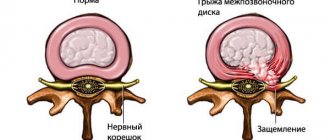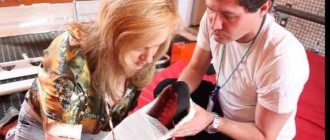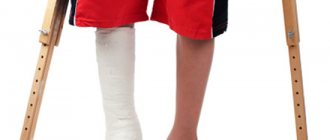From this article you will learn: what diseases may indicate bruises on the legs for no reason in women and men. What to do if you start to get bruises (or, in other words, hematomas) without impacts. Which doctor to contact, how diagnosis and treatment will be carried out.
Author of the article: Victoria Stoyanova, category 2 doctor, head of the laboratory at the diagnostic and treatment center (2015–2016).
Article publication date: 05/19/2017
Article updated date: 02/05/2020
Bruises without injuries on the legs and other parts of the body appear due to weakness of the vascular walls, increased permeability or excessive blood thinning and impaired blood clotting.
The causes of hematomas without impacts are the same in both women and men. However, more often they can appear in women who are fond of wearing high-heeled shoes, as this provokes excessive tension in the legs, stagnation of blood in them and the associated weakening of blood vessels and varicose veins. Also, the strength of blood vessels may decrease during menopause.
If there are problems with blood vessels and blood, bruises often appear on the legs, since these parts of the body are most subject to stress in everyday life. Microtraumas, which manifest as bruises due to pathologies of blood vessels and blood, can occur from long walking, from jumping, and so on.
Hematomas without strokes are a very alarming symptom. If you start to experience bruises on your legs or other parts of your body for no reason, immediately consult a therapist. Depending on the test results, he may refer you to a hematologist, angiologist, phlebologist, hepatologist or gynecologist for further diagnosis and treatment.
Symptoms
Any bruise is manifested by severe pain and the formation of a hematoma.
The most pronounced symptoms of a bruise:
- Swelling in soft tissues.
- Formation of hematoma of the leg.
- Limited leg movements.
- Increased pain within three hours after injury due to expanding hematoma and swelling.
- Lameness.
- Tendon rupture.
Damage to the periosteum on the leg is manifested by pain. When injured, the anterior part of the tibia is often injured due to its close location to the surface of the skin. Therefore, the development of periostitis is possible.
Clinical signs of periostitis:
- severe throbbing pain;
- redness;
- upon palpation and examination, tuberosity with infiltration is determined;
- if the patient’s immunity is weak, the process of cell division in this place is disrupted, they begin to grow chaotically, resulting in calcium spikes;
- as a result, the bones of the lower leg become fused, the mobility of the limb is impaired or completely limited;
- if assistance is not provided in a timely manner, surgical intervention is required.
Useful tips
Traditional medicine gives a lot of advice on how to cure a hematoma on your leg yourself. But sometimes, due to the appearance of a bruise at the most inopportune moment, all plans can be disrupted. That is why you need to promptly consult a doctor and undergo medication treatment.
Representatives of the fair sex want their legs to always look perfect. Small hematomas are not difficult to disguise. Cosmetics with a lasting effect and dense texture can cope with this. A concealer that is a shade darker than your skin tone is best suited for this purpose. To neutralize the blue, apply a layer of yellow corrector underneath.
Injuries are not uncommon on a hike, but few people carry with them a mountain of medicines for all occasions. What to do in this case? Plants help treat bruises. Plantain, coltsfoot, black currant leaf, St. John's wort, and linden are suitable. A paste of greens is applied to the damaged area. Ice can be successfully replaced by cold spring water.
Diagnostics
Diagnosis of the disease is carried out by a traumatologist based on complaints and examination of the patient. Additional examination methods help identify serious violations.
Using CT, radiography and ultrasound, damage to the periosteum is diagnosed. Ultrasound helps detect ruptures of blood vessels and tendons. CT also allows you to evaluate the condition of muscles and soft tissues.
Clinical symptoms help in the differential diagnosis of fractures and bruises. Unlike a bruise, when a leg is broken, the integrity of the bone is disrupted, which causes deformation and shortening of the limb. Movement and support on the leg become impossible. When you try to move a limb, severe pain occurs. Changes in the bones of the leg during a fracture are clearly visible in the X-ray photo.
Why do bruises occur for no apparent reason?
When we take care of ourselves, we look at everything: arms, legs, face. Of course, the appearance of hematomas does not go unnoticed by a woman’s keen eye. If bluish hematomas appear, it does not happen just like that. There is definitely a reason for this phenomenon. Perhaps this is a hidden reason that is not so easy to detect.
You should not take your health lightly if you notice frequent bruises for no apparent reason. So, let’s consider the main factors for the appearance of such “spots” on the body:
- the walls of blood vessels are too fragile;
- thin blood due to low platelet count in the blood.
These are medical reasons that cause large bruises on the legs. Why does this happen, what conditions lead to these factors?
- Old age - due to age-related changes in a woman’s hormonal system, the amount of elastin and collagen secreted significantly decreases. These substances help maintain the strength of blood vessels. During the aging process, the blood vessels are the first to suffer.
- Frequent colds - if a viral infection develops in the body, vascular permeability increases, which leads to the appearance of bruises without impact.
- Taking medications - some medications thin the blood, which leads to small bruises. Ibuprofen, Diclofenac, and certain types of hormonal, anti-asthmatic and antidepressant drugs increase vascular permeability.
First aid
When you bruise your lower leg, it is important to provide first aid correctly; the success of further treatment largely depends on it.
Necessary activities:
- treat existing wounds and other skin lesions with an antiseptic, for example, iodine, alcohol or hydrogen peroxide;
- ensure rest and immobility of the injured limb to relax the muscles;
- create an elevated position by placing a pillow or rolled blanket under your leg;
- apply cold to the injured area for 15-20 minutes;
- for unbearable pain, you can take a painkiller tablet: “Analgin”, “Pentalgin”, “Ketorol”;
- After removing the cold compress, apply a bandage; it will firmly hold the ligaments and muscles in a stationary position and will not allow hemorrhage and swelling to grow.
Attention! The use of warming procedures and ointments in the first 3 days is prohibited! This is fraught with enlargement of the hematoma and increased pain.
What is a hematoma
A hematoma is a large bruise formed after a bruise or blow. A bruise appears due to the fact that small blood vessels and capillaries rupture at the site of the injury. It is visible immediately - a red-violet, purple-blue spot appears at the site of the impact or injury. Bruising is accompanied by swelling, swelling, and pain.
The color of the bruise becomes yellow-green over time, this is due to the breakdown of hemoglobin in the blood. The bruising completely disappears after 15-20 days.
If the color does not change after 2-3 weeks, it becomes even darker, you need to see a doctor, as this indicates an infection. “Boiling” blood is the cause of many complications, which can only be eliminated surgically.
Bruises that appear on the body for no reason are a reason to consult a doctor, because they can signal diseases in the body.
The formation of a hematoma at the site of injury is indicated by sharp pain; the affected area acquires a red-violet hue and swells greatly. If the blow hits the foot, the hematoma and accompanying swelling and pain interfere with the person’s normal movement.
Treatment
Treatment tactics for a shin bruise depend on the extent of the injury. If conservative treatment does not produce results, the resulting compaction is removed through surgery.
After exposure to cold and bed rest, they move on to the next stage of treatment. Now the site of the injury is treated with thermal procedures to resolve the hematoma. For warming up, use alcohol compresses, warming ointments or thermal baths.
Drug therapy includes the following drugs:
- To relieve pain, non-steroidal anti-inflammatory drugs and analgesics are prescribed - “Ketanol”, “Dexalgin”, “Diclofenac”, “Fastum-gel”;
- ointments and creams that thin the blood - “Heparin ointment”, “Rescuer”, “Lioton 1000”;
- ointments with vasodilating properties - “Apizartron”, “Capsicam”, “Viprosal V”;
- to improve regenerative processes in tissues - Wobenzym, Phlogenzyme.
Rehabilitation includes a course of massage, performing special exercises and undergoing manual therapy. These activities are aimed at developing the damaged area. You should not rely on self-medication. To achieve a positive result from therapy, you must follow all the doctor’s instructions.
How to treat a severe bruise of the periosteum of the leg? In the absence of purulent infection, antibacterial agents, cold and non-steroidal anti-inflammatory drugs are prescribed. Loads on the inflamed periosteum are completely eliminated.
If the condition of the periosteum has turned into purulent or ossifying periostitis, surgical intervention is necessary.
Folk remedies
Folk remedies are allowed to be used only as an adjuvant along with drug therapy. Preliminary consultation with a doctor is required.
- Raw potatoes are washed, peeled and cut into slices. Apply to the bruise for 15-20 minutes.
- One onion is crushed to a pulp and applied to the affected area for 20-30 minutes.
- Cabbage leaves or plantain prevent the formation of swelling at the site of injury. The main thing is to change sheets often.
- Mix 2 tablespoons of dry badyagi with warm water, place on gauze and apply to the bruised periosteum, which will help reduce the size of the swelling.
- Arnica tea has an anti-inflammatory effect.
Traditional methods
Treatment of a hematoma on the leg after a bruise with folk remedies allows you to quickly get rid of the bruise and eliminate pain.
Potato compress
In order to quickly fix the problem, you need to peel the potatoes and grate them on a fine grater. The resulting paste is applied to the bruise and secured with a bandage. Remove this compress after two hours. The starch that potatoes are rich in helps quickly get rid of hematomas. The procedure is carried out daily until the bruise disappears.
For hematomas, use potatoes or potato starch
To treat bruises at home, you can use starch itself. The powder is diluted with warm water to a paste and applied to the damaged area. Leave it until completely dry, then wash off. To treat a bruise, 3-4 procedures are enough.
Cabbage compress
You need to take a cabbage leaf from the middle of the head of cabbage and carefully beat it with the blunt side of a knife or a meat mallet. A thin layer of honey is applied to the surface. The sheet is applied to the site of injury, secured with a bandage and left overnight. The procedure is carried out daily until the hematoma disappears.
You can apply a cabbage leaf to the bruise site.
You can also prepare a compress in another way. To do this, cabbage leaves are crushed using a blender, turning them into a paste, which is mixed with a small amount of honey. The product is wrapped in gauze, applied to the damaged area and secured with a bandage. You need to wear it for 6–8 hours. Changes will be noticeable after the second procedure.
Egg compress
The sooner you use such a remedy, the smaller the size of the hematoma will be. A raw, fresh chicken egg is beaten and applied to the damaged area. After it dries without washing off the previous layer, the procedure is repeated. This helps to quickly cope with subcutaneous hemorrhage and reduce pain.
For bruises, using chicken eggs is effective.
In order to enhance the effect, some traditional healers advise adding one teaspoon of salt and a little dry mustard to the egg. This will speed up the process of tissue regeneration.
Aloe
Aloe-based medicines are effective in cases where the hematoma is combined with minor skin damage. To prepare the product, the leaves of the plant are crushed and the juice is squeezed out using gauze (you will need a tablespoon).
Aloe juice can be used for hematomas with skin lesions
Aloe juice is mixed with half a teaspoon of liquid honey. A small piece of fabric is soaked in this solution and applied to the damage. The compress is left for three hours and then removed. The procedure is repeated twice a day.
Horse chestnut tincture
In order to prepare the remedy at home, ripe horse chestnut fruits are thoroughly crushed and placed in a glass jar until half full. Then fill to the top with vodka and leave for a day in a dark place. The tincture is applied to the bruise with a cotton swab 3-5 times a day.
For treatment, you can use tincture of horse chestnut fruits
After the tincture has stood for a month, it needs to be strained. Store this product in the refrigerator for two years. It can also be used to treat varicose veins.
Possible complications
If a bruise occurs, the peroneal nerve, which runs close to the bone, can be damaged, causing numbness and even paresis of the toes.
The most dangerous possible complication is periostitis. The pathology is characterized by a pronounced inflammatory process in the periosteum and is accompanied by bursting, throbbing pain and increased temperature.
The periosteum is an important part of the lower leg, performing the function of feeding bone tissue. Tendons and ligaments are woven into it, promoting bone growth in childhood and the formation of callus during a fracture in an adult.
The result of a severe bone bruise can be detachment of the periosteum and subsequent necrosis and purulent abscess under it . This disease is treated with antibiotics.
Another unpleasant complication is phlegmon . This is a purulent inflammatory process in soft tissues, which often involves muscles, ligaments, joints and bones. Suppuration is caused by staphylococci, streptococci or Pseudomonas aeruginosa. As a result of the breakdown of necrotic tissue, the process is characterized by severe intoxication. Treatment of purulent inflammation is carried out by a surgeon.
Diagnosing the causes of hematomas
In addition to a visual examination of the lower extremities, laboratory blood tests may be needed to determine the cause of bruising. In certain cases, a complete diagnosis of the patient’s health condition is performed. During various pathologies, different hardware examinations are performed:
- During varicose veins, an ultrasound of the vessels of the legs is prescribed, which can show whether the bruises are a consequence of venous disease.
- In case of bruises and injuries, radiography is required, which can help determine the level of damage to blood vessels, joints and bones.
Symptoms and classification
The risk of getting hematomas increases during sports, outdoor activities and in everyday life in the event of a collision, fall or impact with a heavy object.
Hematomas after a bruise on the legs are divided into the following types:
- Subcutaneous. Such injuries are characterized by rupture of capillaries; outwardly they look like an ordinary bruise. In most cases, they are recorded in the lower leg and thigh area. Symptoms of injury: pain in the area of the bruise, tissue swelling, redness and bluishness of the skin. After a couple of days, the bruise turns green, turns yellow, and then disappears.
- Soft tissue hematoma (internal). Hematoma affects muscle fibers. When blood vessels are damaged, blood penetrates into the soft tissues, and when the affected area is felt, a lump is felt. At the site of the formation of an extensive hematoma, severe pain and pulsation are felt. Movement of the injured limb may be difficult. The color of the hematoma ranges from bright red to purple.
- Intra-articular. When a knee is bruised, hemorrhage occurs in the joint cavity (hemarthrosis occurs). It swells, becomes hot to the touch and is very painful. Movement of the injured leg brings unbearable pain caused by stretching of the joint capsule.
Fact! Sometimes, after receiving a hematoma, the victim’s body temperature rises.
Depending on the location of the bruise, hematomas are distinguished on the thigh, toes, foot, ankle, etc.
The mechanism of bruising
Without receiving a blow, bruises on the leg occur due to ruptures of the vascular walls and blood flowing beyond them.
- Hematoma. They form under the skin, deep in the muscle tissue. The affected area hurts a lot.
- Vasculitic purpurea. They are inflammatory in nature, accompanied by itching and rashes.
- Microcirculatory. They are located on the upper and lower extremities and mucous membranes. They occur after heavy blood loss, even with minor exposure to the skin.
- Microcirculatory-hematoma. They are large in size and have a mixed form).
First aid for injury
First aid provided in the first minutes after a bruise plays a very important role. Correct actions immediately after injury help reduce pain and stop hemorrhage, preventing further growth of the hematoma. In this case, we are not talking about small bruises that resolve on their own. Emergency care is necessary for extensive hematomas on the leg after severe bruises.
What should you do after a bruise appears on your leg?
- The first thing is to determine the degree of injury and make sure there is no fracture.
- The next step is to ensure rest for the victim and the injured limb. If the bruise occurs on the fingers, then doctors recommend reducing the load on the sore leg and taking off your shoes. If the pain is severe, you should immediately consult a traumatologist who can diagnose the severity of the injury.
- If the bruise affects the knee area, then you need to give your leg an elevated position (place a pillow or cushion under it). Under no circumstances should you bend your knee.
- Cold is applied to the bruised area for 15-20 minutes (an ice pack, a cold bottle, etc.), the procedure is repeated every hour. It is contraindicated to steam the hematoma in the first two to three days, or to apply heat to the site of its formation.
Interesting! Cold blocks further bleeding, helps reduce tissue swelling and constrict blood vessels.
- If there is an open wound on the leg after a bruise, it must be treated with an antiseptic, a loose, comfortable bandage is applied, and seek help from a traumatologist or surgeon. The doctor diagnoses the severity of the injury and, if necessary, prescribes an X-ray examination.
Medicines
If the hematoma reaches a large size and causes pain, drugs based on serratiopeptidase (Serrata, Movinase, Serox) will help get rid of it in a short time. The active substance is an enzyme isolated from a non-pathogenic intestinal bacterium. It has fibrinolytic, anti-inflammatory, anti-edematous and analgesic effects.
These are preparations for internal use. They are taken 1 tablet 2-3 times a day. The dosage and duration of treatment depends on the nature of the pathological process and is determined by the doctor individually. Therapy should not be carried out in case of hypersensitivity to the components of the drug and blood clotting disorders.
If the bruise is not too large and is more of a cosmetic problem, ointments will help to cope with it. To combat bruises, the same drugs are used as to treat varicose veins.
If the hematoma is the result of serious muscle or joint damage, surgery may be required.
Heparin ointment
There are a large number of ointments whose active ingredient is sodium heparin: Lyoton, Venosan, Heparil, Dioflan, Liotromb, Lyogel. These are direct-acting anticoagulants that quickly eliminate swelling and reduce pain. The drugs in this series resolve blood clots and quickly cope with injuries.
Products containing heparin sodium are used 2–3 times a day
Heparin-based ointments are applied to the bruise and rubbed in gently. The procedure is repeated 2-3 times a day, depending on the severity of the condition, until the hematoma resolves. Treatment can last from 3 to 10 days. The ointment is practically not absorbed into the bloodstream and does not have a systemic effect.
It is not recommended to use it in case of hypersensitivity to the components or bleeding disorders. Do not apply the product to open wounds.
Troxerutin
To treat hematomas at home, you can use ointments based on troxerutin: Troxevasin, Troxerutin, Troxegel, Phleboton. The active ingredient is a mixture of bioflavonoids that penetrate the venous walls, strengthening them and improving microcirculation. The drug quickly removes swelling and eliminates pain.
For bruises, the use of external agents with troxerutin is effective.
In order to get rid of a bruise on the leg, ointments based on troxerutin are applied in the morning and evening and rubbed in with light massage movements. The duration of treatment is from 5 to 10 days.
Troxerutin should not be applied to damaged skin or eczematous areas. It is not recommended to use it if you are hypersensitive to the active substance.
Dolobene
If the hematoma reaches a large size and causes pain, Dolobene gel will help get rid of it. This is a combination product that contains sodium heparin, dimethyl sulfoxide and dexpanthenol. They have anti-inflammatory, decongestant and analgesic effects, and also accelerate tissue regeneration.
Dolobene is a combination drug with anti-inflammatory, anti-edematous and analgesic effects.
The gel is applied to the damaged area in a thin layer and rubbed in easily. If there is an abrasion on the surface of the bruise, apply the product around it. The drug is used 2 to 4 times a day. The effect of its use becomes noticeable on the second day.
Dolobene should not be used in case of severe impairment of liver and kidney function, during pregnancy and lactation, and in case of severe disorders of the cardiovascular system. The gel is not applied to open wounds or trophic ulcers, and it is also not recommended for use in cases of bleeding disorders.
Treatment of hematoma on the leg after a bruise
Small hematomas are treated conservatively in most cases. In case of severe bruises that lead to the formation of extensive internal hematomas, surgical intervention may be necessary - surgery to remove accumulated fluid, surgical restoration of blood vessels, etc.
Conservative treatment
Hematomas of mild and moderate severity are treated with medications that improve blood circulation, promote the resorption of bruises, relieve pain and swelling: gel Lyoton, Dolobene, Trombless, “Rescuer”, Troxevasin, heparin ointment, Ketonal, Fastum-gel, “Dikul”, etc. .
Sometimes physical therapy may be required to accelerate the regeneration process: electrophoresis, magnetic therapy, etc.
The victim is prescribed analgesics and vitamins. If necessary, three days after the injury, the leg is additionally lubricated with warming ointments and compresses are made. To relieve the limb, fixing bandages are used when walking.
Interesting! Ascorbic acid strengthens the walls of blood vessels and reduces capillary fragility.
Surgical methods of treatment
Methods of surgical treatment:
- stopping bleeding through surgery;
- puncture - “suction” of the contents of the hematoma with a syringe;
- surgical restoration of the anatomical integrity of a tendon or muscle;
- osteosynthesis and suture of the patella for hemarthrosis, drainage, etc.
The postoperative period requires long-term restoration of limb function. In case of hemarthrosis, a plaster splint is applied to immobilize the joint.
Hematomas of mild to moderate severity disappear after a few days. Full recovery from surgery may take up to several weeks or months.
Precursors of other diseases
But sometimes it happens that bruises appear for no apparent reason, when there were no falls, no bruises, no painful touches. In such cases, a person is surprised - where is he from and not alone? He notices that the spots appeared as traces of finger pressure on different parts of the body. What if they could be harbingers of serious diseases associated not only with blood vessels? It is clear that ruptures occur due to the fragility and permeability of the walls of blood vessels and capillaries. Why do they become thin and vulnerable?
Firstly , some women have very thin, delicate skin. Capillaries and vessels lying on the very surface of the body are visible through them. The slightest touch can injure the capillaries. Usually they have bruises after anti-cellulite or cupping massage, deflation or rubbing.
Bruising can also occur as a result of many diseases associated with deterioration of blood quality: decreased hemoglobin, platelets, and coagulation. And then, with the slightest pressure, a bruise appears on the body. The same can happen if people take blood thinning drugs: aspirin, Cavinton and their analogues.
With diseases such as leukemia or thrombocytopenia, the blood loses its beneficial properties and becomes either viscous or very liquid. When clotting occurs, nosebleeds or internal bleeding often occur, causing a lot of blueness.
With viral diseases of the liver and kidneys, a scattering of small hemorrhages suddenly appears throughout the body. The person may have developed hemorrhagic vasculitis. In this case, inflammation of the microvessels of the body occurs on the walls of the vascular system with the formation of microthrombi. The disease requires urgent hospital treatment.
Another reason that causes bruising is thrombosis or thrombophilia, associated with the formation of blood clots in the vessels. Where the vascular wall is damaged, a blood clot forms. This normal cellular process to prevent blood loss at the site of injury sometimes becomes excessive. Then such cell activity causes excessive formation of a blood clot, which prevents the outflow of blood through the vein.
You need to carefully feel the blue spot on your leg. If it is located on the vessel and has a convex shape, then thrombophilia can be suspected. Typically, a bruise from a blood clot on the lower leg causes an unpleasant sensation, becomes red and swollen. Medical consultation, hardware diagnostics and further serious treatment are required.
Possible complications
Even a small and seemingly harmless bruise, if treated incorrectly, can lead to serious consequences, for example, suppuration of the bruise. Internal hematomas are sometimes accompanied by infection and purulent inflammation. When damaged skin peels off at the site of a bruise, traumatic lumps (cysts) can form, which can only be removed through surgery. If bed rest is violated after surgical treatment, repeated accumulation of blood in the joint (hemarthrosis) is possible. Severe injuries and extensive bruising can lead to tissue necrosis.
Under no circumstances should hematomas, especially large ones, be left without the attention of doctors.
Of course, accidental injury cannot be prevented in advance, but its consequences can be minimized. To strengthen blood vessels, muscles and bones, you need to eat a balanced diet, lead a healthy lifestyle and exercise - all this together will help prevent the development of serious complications after bruises.
Why are bruises dangerous?
On the Internet you can find a lot of recommendations on how to remove a small bruise on your leg at home. But few people think that not all hematomas are harmless, and self-medication can cause many complications, among which suppuration takes the leading place. Sometimes a simple bruise can lead to serious problems and complications over time. For example, a bruise caused by a blow can develop into a cyst, which will require surgery to get rid of. An advanced hematoma, in which pus begins to accumulate, can cause sepsis and tissue death.
After receiving an injury, not all people are accustomed to seeing a doctor “for trifles,” believing that they can get rid of a bruise without the intervention of specialists. But we must not forget that a blow or an unfortunate fall often causes more serious injuries. If severe pain does not go away even after a few hours, and the swelling intensifies, contact a traumatologist and take an x-ray to rule out fractures and cracks.
Treatment of internal hematomas also often requires drug therapy with antibiotics, so sometimes it is better to be safe than to start the disease. In the vast majority of cases, internal hematomas are treated surgically. If surgery is not done in time, it can rupture and cause serious complications and death. Also, with an internal hematoma, the body loses blood. Internal hematomas can be diagnosed using ultrasound diagnostics.
Causes
Bruising of the periosteum and shin is a common occurrence among athletes and football players. Such injuries do not always force the victim to immediately consult a doctor, so people often come to the appointment with old injuries, the causes and initial symptoms of which cannot be identified. Treatment of old lesions is carried out according to clinical manifestations.
The main causes of bruises of the lower leg and periosteum are impacts and falls. A blow, depending on the individual characteristics of the body and its strength, can provoke a slight bruise. However, there are categories of people for whom even a minor blow or fall causes injury. These include:
- children,
- old people,
- patients suffering from diseases of the musculoskeletal system,
- patients who suffer from hypocalcemia.
What to do if there is a hematoma that occurs without a reason?
The vast majority of hematomas occur as a result of severe bruising or serious damage to bones and joints (fracture, rupture, tear, crack, etc.). However, there are cases of detection of an injured area of blood vessels without an objective reason for its formation.
In such a case, it is advisable for a person who regularly notices such phenomena on his body to examine the body for the presence of pathological processes. First of all, you should make sure that there are no diseases of the venous system, in particular thrombosis and thrombophlebitis.
Separately, it is worth noting the natural occurrence of hematomas without previous bruises or injuries in people who have been taking steroids or other hormonal boosters for a long time. Such additives can not only negatively affect the functioning of the gastrointestinal tract, but can also result in thinning of blood vessels and vein walls, as well as disturbances in the circulatory system.
Based on the information above, if you are diagnosed with a bruise that has arisen for no reason, you should consult a doctor as soon as possible to identify abnormalities in the body’s functioning and their timely correction.
Symptoms of injury
Symptoms of a shin bruise are expressed by severe pain, which sometimes leads to fainting of the victims. The signs of a bruise are as follows:
- the muscles of the lower leg hurt incredibly strongly,
- a large hematoma (bump) appears at the site of the injury, which can persist for several years, often filled with infiltrate,
- the bone also hurts,
- the lump after a bruise is inflamed, accompanied by swelling,
- After some time, a compaction forms in the area of damage, the skin acquires a red, purple tint,
- if blood vessels are injured, internal hemorrhage is diagnosed.
Such processes contribute to compression of nearby nerves and tissues. A day after the injury, the lower leg begins to hurt more intensely, as a result of which the symptoms become more pronounced. Pain is also present in other parts of the body. An infiltrate gradually accumulates in the area of the knee joint, which compresses tissues, muscles and nerves, thereby preventing the ability to move. The blood in this place does not resolve on its own, so it is necessary to pump it out using special methods.
Interesting! The color of the skin after a bruise is different. At first, manifestations of a red-brown color are possible, but as the hematoma resolves, it turns into a blurry yellow-green hue.
Bruises on different parts of the body
When studying the reasons for the formation of bruises on the body, you will notice that in different people they occur mainly in the same places. Based on their location, we can identify the main reasons for their appearance in a particular place.
Table 1. The main causes of bruising in certain parts of the body:
| Part of the body | The most common causes of bruises | ||||
| Legs | Varicose veins | Avitaminosis | Liver problems | Collapsibility | Hormonal disorders |
| Hands | Hemorrhagic vasculitis | Vitamin C deficiency | |||
| Eyelids | Loss of firmness and elasticity of tissues and vessel walls | Hormonal disorders | Oncology | Taking medications that thin the blood | |
| Stomach | Disorders of the cardiovascular system | ||||
| Knees | Avitaminosis | Taking medications that affect liver function | Kidney dysfunction | Phlebeurysm | |
| Fingers of the limbs | Violation of the walls of blood vessels | Hormonal imbalance | |||
If bruising is specific to one specific area of the body, it is important to look at the possible causes and do an in-depth blood test to identify the specific causes of the bruising.
Bruises in women after childbirth
Pregnancy is a wonderful period, but at the same time very difficult for the female body. Many women after childbirth notice the formation of bruises on their body in different places. The main causes of bruises after pregnancy:
- phlebeurysm;
- avitaminosis;
- hormonal imbalance;
- decrease in hemoglobin level in the blood;
- taking medications that have an effect on blood thinning.
During pregnancy, the mother's body accumulates all the beneficial substances and transfers them to the child. As a result, a woman does not receive enough vitamins that her body needs and because of this, serious changes occur. The walls of the blood channels become thinner, the blood itself becomes thicker and more immobile.
During this period, blood circulation changes and to improve it, many are prescribed blood thinners.
The vessels cannot withstand heavy loads, and bruising occurs. Those parts of the body that experience the greatest stress are especially susceptible. For pregnant women, these are the legs and stomach. The skin on the abdomen is greatly stretched, as a result of which the capillaries become more brittle. The walls of blood vessels become thinner.
Varicose veins occur in almost half of pregnant women. This is due to the fact that due to the need to supply the uterus with blood, the flow of blood to the lower extremities is limited. Arterial blood stagnates below, resulting in some stagnation of venous blood. Thin blood vessels burst, forming a thin blue mesh on the skin. When there is stagnation in large veins, the channel swells, and they stand out noticeably in the form of bumps on the skin.
Also, after childbirth, a woman’s hormonal levels change. This is a natural process, but sometimes there are failures when the level of a certain hormone is not normal. As a result, this can cause hematomas.
Bruises under the eyes
On women's faces, the skin is thin and the capillaries are located close. Some people have small blood vessels under their eyes constantly throughout their lives. This is due to the fact that the vessels are fragile. For some, this is a congenital feature. But in most cases, the following reasons lead to the formation of bruises:
- Unhealthy Lifestyle;
- drinking alcohol and smoking;
- working on a computer;
- kidney disease;
- heart and vascular diseases;
- eye diseases.
The formation of bruises under the eyes is greatly influenced by an unhealthy lifestyle, bad habits, stress and lack of sleep. Smoking and drinking alcohol have a particularly negative impact. Smoking cigarettes causes blood vessels to narrow. Small capillaries on the face become clogged and characteristic bruises appear. Alcohol affects capillary fragility. With its excessive use, the blood vessels begin to burst, forming bruises under the eyes.
In cases of a stressful lifestyle, long work at the computer, lack of sleep, blood flow towards the face increases. The vessels cannot withstand the increased load, which causes the formation of blue skin under the eyes.
With age, many women also experience worsening blood circulation and increased fragility of blood vessels.
Also, diseases of various organs are a consequence of age-related changes in the face. When the heart malfunctions, blood stagnation occurs, leading to hematomas. Kidney diseases such as pyelonephritis have a particular impact.
That is why it is important to monitor your health and provide yourself with medical care on time. Treating the disease at an early stage will help the body cope with it faster.
First aid
A bruised leg requires immediate first aid. Thanks to this, it is possible to reduce the risk of complications. First, the victim needs to be calmed down and a compressive bandage applied to the injury site. It will reduce hematoma and pain. Loads on the leg should be avoided if the shin is bruised.
What to do if you bruise your shin
First aid after a bruise is as follows:
- The victim must be provided with rest, reassured, and given an anesthetic that relieves pain. For pain, nonsteroidal anti-inflammatory drugs (Nimesil, Nimid, Analgin, Ketorol, Ketanov) can be used.
- In the area of the bruise, it is necessary to use a cold compressive bandage, which will reduce pain and hemorrhage. Typically, the bandage is applied dry, secured tightly, and then an ice pack is placed on top of it. If you don't have ice on hand, you can use any frozen product from the refrigerator. Cooling of the lower part of the lower leg is carried out intermittently until an ambulance specialist arrives.
- If a fracture is suspected, the injured limb is fixed using a splint or any available material.
- To reduce hemorrhage, it is important to place the lower limb on an elevation, this will reduce the outflow of blood and minimize the area of edema.
It is important to remember that assistance with a bruise allows you to minimize complications.
Bruises on the legs are a sign of what disease?
The cases described above, when bruises on the legs appear on their own, occur as a result of a non-system failure and after corrective actions the situation is corrected. In some cases, the etiology of hematomas on the legs is more serious - it may be a serious illness, internal pathology or genetic “inheritance”. More often than other diseases, the appearance of hematomas for no reason is caused by blood diseases and diseases affecting the vascular system:
- hemophilia;
- lupus erythematosus;
- von Willebrand disease;
- hemorrhagic vasculitis.
Bruises on legs due to varicose veins
Varicose veins are one of the diseases in which bruises appear on the legs, the reasons for this are weakening of the veins and chronic blood stagnation. Among women, varicose veins are more common, since ladies often get carried away by walking in high heels, which provokes tension in the legs and stagnation of blood in the veins. In some cases, brownish spots mistaken for bruises may turn out to be a complication of varicose veins - dangerous trophic ulcers.
Bruises on legs due to hepatitis
A frequently occurring hematoma on the leg may be a sign of a serious illness - hepatitis. With this disease, the production of platelets is disrupted, which causes a decrease in blood clotting, which results in the appearance of bruises on the legs. In severe cases of hepatitis and other severe liver diseases, bruises begin to appear all over the body, and the skin becomes yellowish in color.
Bruises on the legs due to diabetes
Elevated blood sugar causes many complications and disruptions in the body, one of which is that bruises on the legs do not go away. Metabolic disorders in diabetes lead to damage to small vessels, resulting in bruising. Dark spots caused by various dermatitis can also be mistaken for bruises in this disease. Skin diseases in this case arise due to impaired blood supply to the epidermis.
Bruises on the legs due to leukemia
The blood disease leukemia is another case where bruises appear on the legs for no reason. With leukemia, malignant changes occur in the blood, the cellular structure of platelets is disrupted, and the number of red blood cells is significantly reduced. Bruising during the disease occurs on any part of the body, but mainly on the limbs. In addition to the usual bruises with leukemia, petechiae appear on the skin - specific small bruises similar to a rash.
Bruises on legs due to HIV
Anyone who wonders why bruises appear on their legs is unlikely to know that this is one of the symptoms of HIV. This virus very often causes thrombocytopenia - a decrease in platelet levels, as the infection can damage the red bone marrow and megakaryocytes that produce platelets. Sometimes the immune system of a person infected with HIV itself begins to fight platelets.
Diagnosis and treatment
It is believed that if after an injury a person is able to move his leg at least partially, its integrity is not compromised. However, it will not be possible to limit yourself to this method alone, since the doctor needs to see the full picture of the injury in order to prescribe the correct treatment for a bruised leg. Contusion of the periosteum and tibia is usually diagnosed using MRI, radiography and ultrasound.
Thanks to MRI, it is possible to assess the condition of the muscles that were injured, as well as soft tissues. This method is especially important if the patient has swelling as a result of a severe bruise, internal hemorrhage and hematoma. X-rays can be used to assess the condition and integrity of the bone. Thanks to ultrasound, you can see what changes have occurred in the tissues, whether there are bruises, as well as ruptures of tendons or blood vessels.
An important stage of diagnosis, in addition to the methods described above, is also questioning and examining the patient for the presence of visible skin lesions and fistulas.
Important! A fistula is a canal that connects soft and bone tissues to the surface of the skin. As a rule, fistulas occur with severe bruises and are accompanied by infection. Treatment of fistulas must be carried out immediately, as the infection will spread deeper into the tissue and cause irreparable harm to the body.
Treatment of a bruised leg is carried out immediately after diagnosis.
Treatment methods for bruises are as follows:
- In the first day or two after injury, the victim is prescribed bed rest. If complete rest cannot be ensured, it is necessary to minimize the load on the injured limb. In the first 1–2 days, applying cold to the injury site is also indicated.
- Starting from the third day of treatment, when there are no bruises, the use of agents that dissolve blood clots and relieve swelling is indicated (Heparin, Hepatrombin, Bruise-Off, Rescuer, Lyoton gel, Hemoclar).
- The use of warm water compresses or baths, as well as alcohol-containing compresses, is recommended.
- Sometimes doctors recommend applying an iodine mesh, which helps the hematomas resolve.
- The use of anti-inflammatory drugs is indicated to reduce pain and inflammation in the affected areas. To do this, use gels, ointments or creams (Voltaren, Iubfen, Ketoprofen, Nimid).
Diseases that cause bruising
If bruises appear in women without mechanical causes, this may be a signal from the body about the presence of a serious illness. Such diseases include:
- disturbances in the functioning of the endocrine system;
- problems with the heart and blood vessels;
- varicose veins, which provokes multiple formation of hematomas;
- violation of the level of platelets in the blood;
- kidney and urology problems;
- liver diseases;
- high blood pressure;
- rheumatism.
It often happens that during the treatment of one disease, such potent drugs are prescribed that can negatively affect the functioning of other organs.
Frequent studies have confirmed that when using an anti-inflammatory drug called Ibuprofen, many people experienced bruises on their bodies.
There are many other medications, after the use of which, one of the negative consequences may be the destruction of the walls of blood vessels or blood thinning. If a woman notices bruises on her body after taking certain medications, she should stop using it.
Rehabilitation
Rehabilitation for a shin injury is aimed at quickly restoring leg mobility, reducing swelling and eliminating pain at the site of injury. An important step in the beginning of rehabilitation is the development of the injured leg. The sooner the recovery process occurs, the faster you will be able to fully return to a normal lifestyle. But it is worth remembering that you cannot load your leg right away. Excessive or sudden stress on the leg can cause additional injuries.
For the purpose of rehabilitation, it is recommended to do therapeutic exercises, water procedures and massage.
Hematoma formation and its manifestations
A leg bruise is considered a fairly minor injury, however, this injury is often accompanied by the formation of a hematoma.
A hematoma is an accumulation of blood in the subcutaneous tissue. This manifestation is very typical for an injury such as a bruise, which is caused by rupture of capillaries and disruption of the integrity of small blood vessels. This happens as follows. As a result of a bruise, blood from damaged vessels accumulates in a certain area, after which a specific sheath of connective tissue forms around it. When a hematoma appears, the patient experiences the following clinical manifestations:
- Painful sensations;
- Swelling;
- Increase in local temperature indicators;
- Change in skin color (skin color in the area of damage can change from red-blue to black, green, yellow).
Pain is usually felt when touching the damaged area, as well as when trying to move the leg. Traumatologists distinguish the following degrees of hematomas, according to the established classification:
- Mild - appears within 24 hours after the injury. Accompanied by slight swelling and minor bruising. It goes away within a few days on its own or with the use of absorbable ointments.
- The average degree appears after approximately 3–5 hours from the moment of injury. Accompanied by moderate pain, swelling, and limitation of motor activity.
- Severe degree - becomes noticeable within an hour and a half after the injury. It is accompanied by severe pain, extensive swelling, cyanosis of the skin and an almost complete lack of motor activity in the affected leg.
For moderate and severe hematomas, it is strongly recommended to contact a qualified specialist in order to prescribe an adequate and effective therapeutic course!
Diagnosis of injury
Identifying a hematoma is not difficult for medical professionals. Just the presence of a bruise and swelling is enough. However, in case of extensive hemorrhages, it is important to conduct a diagnosis in order to exclude concomitant injuries. For this purpose, patients may be recommended the following types of studies:
- X-ray examination;
- Taking a puncture of the knee joint;
- Arthroscopy (performed when bloody impurities are detected in the punctate).
Based on the results obtained, the doctor will be able to make an accurate diagnosis to the victim and prescribe the necessary treatment, which will be optimal in a particular clinical case.











